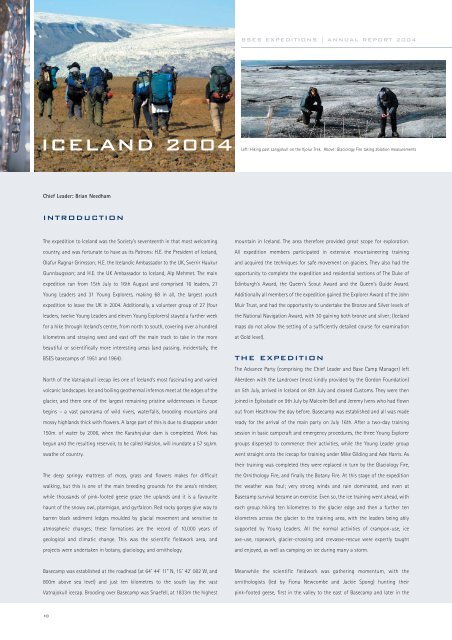FinalAnnReport 2004 _artwork - Hugha.co.uk
FinalAnnReport 2004 _artwork - Hugha.co.uk
FinalAnnReport 2004 _artwork - Hugha.co.uk
You also want an ePaper? Increase the reach of your titles
YUMPU automatically turns print PDFs into web optimized ePapers that Google loves.
ICELAND <strong>2004</strong><br />
Chief Leader: Brian Needham<br />
INTRODUCTION<br />
The expedition to Iceland was the Society’s seventeenth in that most wel<strong>co</strong>ming<br />
<strong>co</strong>untry, and was fortunate to have as its Patrons: H.E. the President of Iceland,<br />
Olafur Ragnar Grimsson; H.E. the Icelandic Ambassador to the UK, Sverrir Ha<strong>uk</strong>ur<br />
Gunnlaugsson; and H.E. the UK Ambassador to Iceland, Alp Mehmet. The main<br />
expedition ran from 15th July to 16th August and <strong>co</strong>mprised 16 leaders, 21<br />
Young Leaders and 31 Young Explorers, making 68 in all, the largest youth<br />
expedition to leave the UK in <strong>2004</strong>. Additionally, a volunteer group of 27 (four<br />
leaders, twelve Young Leaders and eleven Young Explorers) stayed a further week<br />
for a hike through Iceland’s centre, from north to south, <strong>co</strong>vering over a hundred<br />
kilometres and straying west and east off the main track to take in the more<br />
beautiful or scientifically more interesting areas (and passing, incidentally, the<br />
BSES basecamps of 1951 and 1964).<br />
North of the Vatnajokull icecap lies one of Iceland’s most fascinating and varied<br />
volcanic landscapes. Ice and boiling geothermal infernos meet at the edges of the<br />
glacier, and there one of the largest remaining pristine wildernesses in Europe<br />
begins – a vast panorama of wild rivers, waterfalls, brooding mountains and<br />
mossy highlands thick with flowers. A large part of this is due to disappear under<br />
150m. of water by 2006, when the Karahnj<strong>uk</strong>ar dam is <strong>co</strong>mpleted. Work has<br />
begun and the resulting reservoir, to be called Halslon, will inundate a 57 sq.km.<br />
swathe of <strong>co</strong>untry.<br />
The deep springy mattress of moss, grass and flowers makes for difficult<br />
walking, but this is one of the main breeding grounds for the area’s reindeer,<br />
while thousands of pink-footed geese graze the uplands and it is a favourite<br />
haunt of the snowy owl, ptarmigan, and gyrfal<strong>co</strong>n. Red rocky gorges give way to<br />
barren black sediment ledges moulded by glacial movement and sensitive to<br />
atmospheric changes; these formations are the re<strong>co</strong>rd of 10,000 years of<br />
geological and climatic change. This was the scientific fieldwork area, and<br />
projects were undertaken in botany, glaciology, and ornithology.<br />
Basecamp was established at the roadhead (at 64˚ 44’ 11" N, 15˚ 42’ 082 W, and<br />
800m above sea level) and just ten kilometres to the south lay the vast<br />
Vatnajokull icecap. Brooding over Basecamp was Snaefell, at 1833m the highest<br />
10<br />
BSES EXPEDITIONS | ANNUAL REPORT <strong>2004</strong><br />
Left: Hiking past Langjokull on the Kjolur Trek. Above: Glaciology Fire taking ablation measurements<br />
mountain in Iceland. The area therefore provided great s<strong>co</strong>pe for exploration.<br />
All expedition members participated in extensive mountaineering training<br />
and acquired the techniques for safe movement on glaciers. They also had the<br />
opportunity to <strong>co</strong>mplete the expedition and residential sections of The D<strong>uk</strong>e of<br />
Edinburgh’s Award, the Queen’s S<strong>co</strong>ut Award and the Queen’s Guide Award.<br />
Additionally all members of the expedition gained the Explorer Award of the John<br />
Muir Trust, and had the opportunity to undertake the Bronze and Silver levels of<br />
the National Navigation Award, with 30 gaining both bronze and silver; (Iceland<br />
maps do not allow the setting of a sufficiently detailed <strong>co</strong>urse for examination<br />
at Gold level).<br />
THE EXPEDITION<br />
The Advance Party (<strong>co</strong>mprising the Chief Leader and Base Camp Manager) left<br />
Aberdeen with the Landrover (most kindly provided by the Gordon Foundation)<br />
on 5th July, arrived in Iceland on 8th July and cleared Customs. They were then<br />
joined in Egilsstadir on 9th July by Mal<strong>co</strong>lm Bell and Jeremy Ivens who had flown<br />
out from Heathrow the day before. Basecamp was established and all was made<br />
ready for the arrival of the main party on July 16th. After a two-day training<br />
session in basic campcraft and emergency procedures, the three Young Explorer<br />
groups dispersed to <strong>co</strong>mmence their activities, while the Young Leader group<br />
went straight onto the icecap for training under Mike Gilding and Ade Harris. As<br />
their training was <strong>co</strong>mpleted they were replaced in turn by the Glaciology Fire,<br />
the Ornithology Fire, and finally the Botany Fire. At this stage of the expedition<br />
the weather was foul; very strong winds and rain dominated, and even at<br />
Basecamp survival became an exercise. Even so, the ice training went ahead, with<br />
each group hiking ten kilometres to the glacier edge and then a further ten<br />
kilometres across the glacier to the training area, with the leaders being ably<br />
supported by Young Leaders. All the normal activities of crampon-use, ice<br />
axe-use, ropework, glacier-crossing and crevasse-rescue were expertly taught<br />
and enjoyed, as well as camping on ice during many a storm.<br />
Meanwhile the scientific fieldwork was gathering momentum, with the<br />
ornithologists (led by Fiona New<strong>co</strong>mbe and Jackie Spong) hunting their<br />
pink-footed geese, first in the valley to the east of Basecamp and later in the


